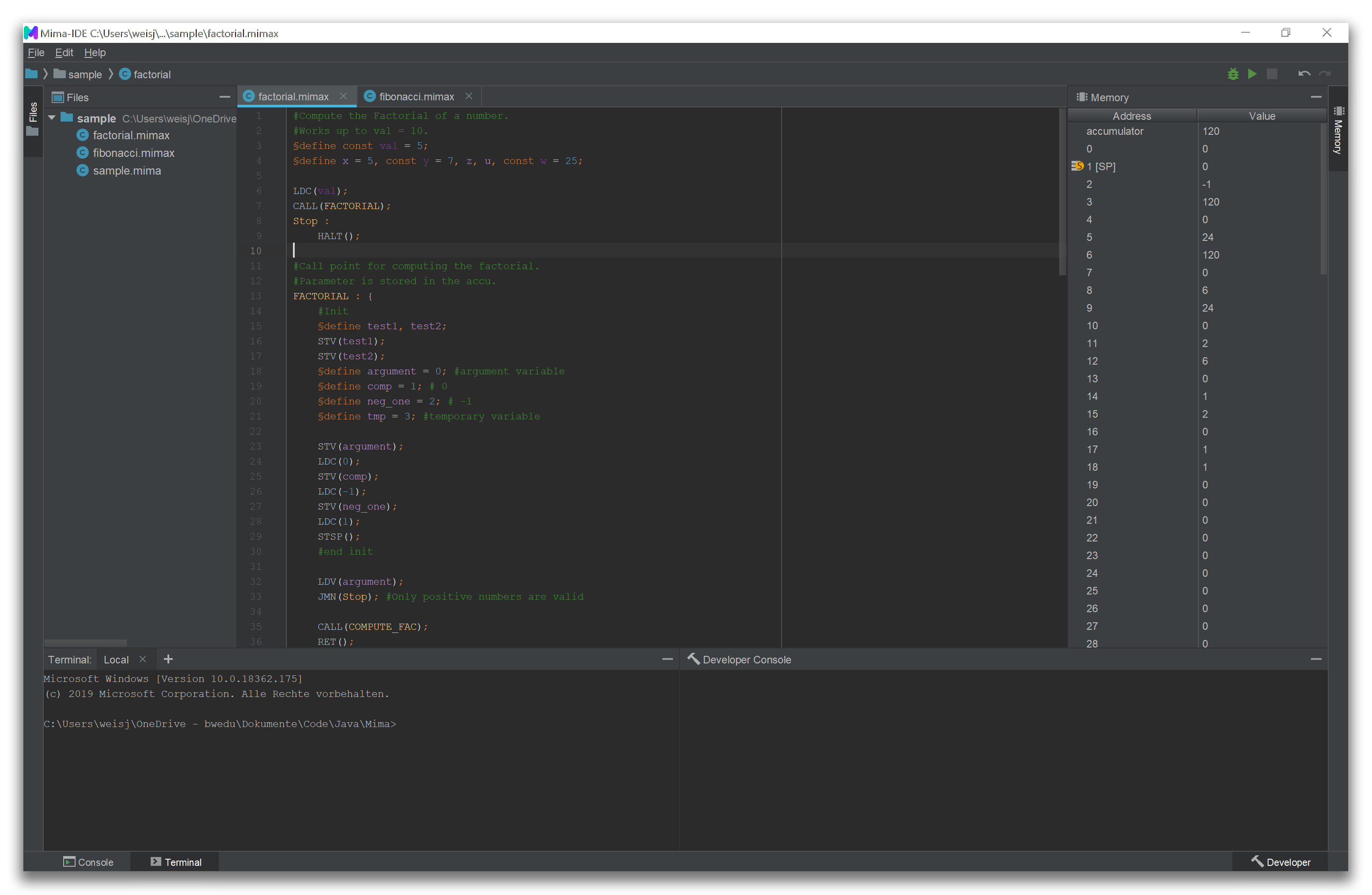Simple environment for writing Mima-Code (see http://gbi.ira.uka.de/ chapter 10)

This is a simple IDE developed for writing code targeted at the Mima (Minimal Computing Machine) taught at KIT (Karlsruher Intitute for Technology).
This is a personal project to gain experience in GUI programming using the Java Swing Api. The design is based on the design of the Jetbrains product and builds on the open-source Darcula Look and Feel but extends it in a lot of ways to keep up with the newer Darcula design with didn't yet make it into the LaF.
You can run either the jar or executable from .\build or the release page. No further installation is needed. You can also compile it yourself using maven.
The Mima or minimal Machine is an idealized Prozessor taught at the KIT. It uses, as the name implies, a minimal set of prozessor instruction to achieve full computational power.
The Mima uses registers that are 24bit long and store numbers in twos complement. To encode the instructions the first four bytes of the register are reserved and the remaining 20 bits are used for the argument. This implies that arguments can only be positive numbers as negative numbers need to be stored in 24 bits.
An extended version of the Mima called MimaX adds some further capabilities to support callstacks and 24bit values in adresses and argument constants.
<a> denotes the value in memory at address a
c is a constant value
accu is the accumulation register
iar is the instruction address register
sp is the stack pointer
rs is the return stack
Mima Instructions:
| Instruction | Description |
|---|---|
| LDC c | c ⟶ accu |
| LDV a | <a> ⟶ accu |
| STV a | accu ⟶ <a> |
| LDIV a | <<a>> ⟶ accu |
| STIV a | accu ⟶ <<a>> |
| NOT | invert all bits in accu |
| RAR | rotate bits in accu one place to the right |
| ADD a | accu + <a> ⟶ accu |
| AND | accu AND <a> ⟶ accu (bitwise) |
| OR | accu OR <a> ⟶ accu (bitwise) |
| XOR | accu XOR <a> ⟶ accu (bitwise) |
| EQL a | if <a> = accu then -1 ⟶ accu else 0 ⟶ accu |
| JMP c | c ⟶ iar |
| JMN c | if msb of accu = 1 then c ⟶ iar |
Additional MimaX Instructions:
| Instruction | Description |
|---|---|
| CALL c | rs.push(iar) and c ⟶ iar |
| RET | rs.pop() ⟶ iar |
| ADC c | accu + c ⟶ accu |
| LDSP | sp ⟶ accu |
| STSP | accu ⟶ sp |
| STVR disp,SP | accu ⟶ < + disp> |
| LDVR disp,SP | <<sp> + disp> ⟶ accu |
The IDE utilizes an internal Mima language with makes it easier to produce working code.
- Comments:
#...or#...#. - Definitions:
§define "def" = "value"(use with e.g. STV "def").§define const "ref" = "value"(use with e.g. LDC("ref"))."ref" : ...(use with e.g. JMP "ref").
- Statements must be terminated by
;. - Arguments are passed within parenthesis (e.g.
STV(5),LDVR(1,SP()) SPis a function call, so it has to be used by typingSP()and notSP.- You can use scopes
{ ... }for variable shadowing. Variables are lost outside the scope except they explicitly define a memory cell. Constants are lost indefinitely. - Variables must be defined before they can be used. Jumps are the only exception for this.
- You can not jump into an inner scope. Jumps can only occur within the same or an outer scope.

